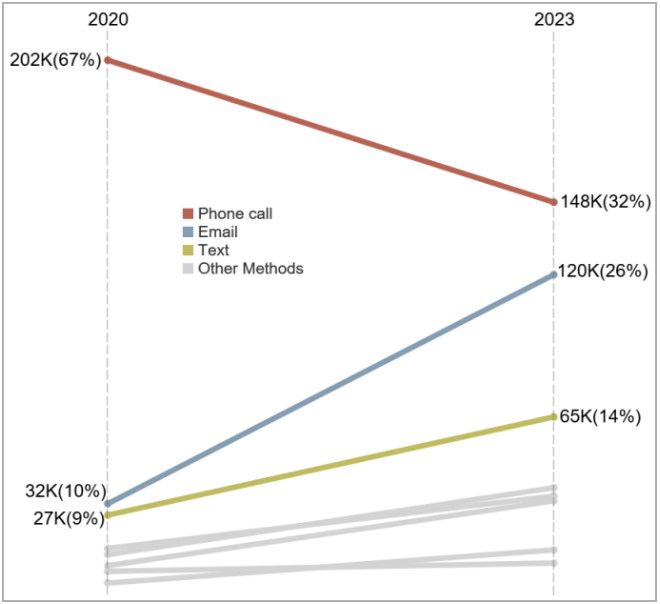FTC: Americans lost $1.1 billion to impersonation scams in 2023
Impersonation scams in the U.S. exceeded $1.1 billion in losses last year, according to statistics collected by the Federal Trade Commission (FTC), a figure that is three times higher than in 2020.
The agency compiled this data based on 490,000 reported scams in 2023. Of these, 330,000 were for business impersonation complaints and the rest represent government impersonation incidents.
According to the agency, most of the scams were conducted via phone calls, currently in decline, followed by email and text messages, which are on the rise for the third year in a row.

Impersonation incidents reported to FTC (ftc.gov)
"Reports show an increasingly blurred line between business and government impersonation scams," reads the FTC report.
"Many scammers impersonate more than one organization in a single scam – for example, a fake Amazon employee might transfer you to a fake bank or even a fake FBI or FTC employee for fake help."
The top five scam types FTC highlights are:
- Copycat Account Security Alerts: Scammers send fake alerts about unauthorized account activity, tricking victims into transferring funds for protection.
- Phony Subscription Renewals: Emails claim a subscription you never had is renewing, coaxing you into a refund scam that involves returning over-refunded amounts via gift cards.
- Fake Giveaways, Discounts, or Money to Claim: Scams offer bogus discounts or giveaways from known brands, leading victims to buy gift cards or send money to claim the non-existent offers.
- Bogus Problems with the Law: Impersonators claim you're implicated in a crime, pushing you to move money or buy gift cards under the guise of resolving the issue.
- Made-up Package Delivery Problems: Fraudulent messages from carriers about delivery issues, aiming to steal credit card information or account details under the pretense of resolving a delivery problem.
The agency provides tips for consumers to protect against this type of fraud, which include avoiding clicking on URLs arriving via unsolicited communications, distrusting requests for money transfers, and taking the time to verify suspicious communications.
Simultaneously, the FTC announced on April 1 that new impersonation rules are coming into effect. These rules aim to give the agency enhanced capabilities to pursue scammers in federal courts for civil penalties and restitution.
As noted in a press release published two months ago, the FTC will be given the power to directly seek monetary relief from scammers that use forged government seals and business logos, spoof government and business email and web addresses, and falsely imply affiliation with them.
Source: bleepingcomputer.com
Bạn cũng có thể quan tâm
All Rights Reserved | John&Partners LLC.






